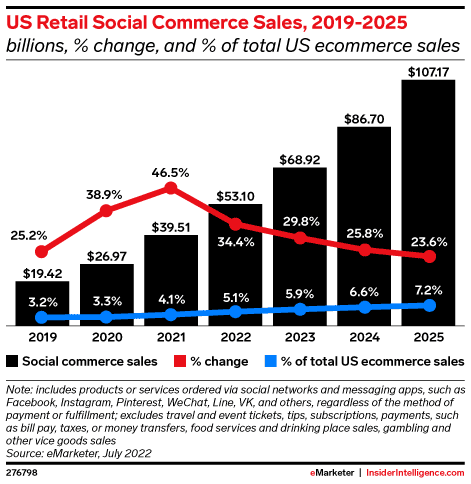How Social Commerce is Changing Retail
Discover how social media and e-commerce are merging to create a new way of shopping. Join us as we explore the future of shopping through social commerce.

Hey there! Are you curious about how social media and e-commerce are coming together (social commerce) to change the way we shop? Well, you’ve come to the right place!
In this blog post, we’re going to take a deep dive into the world of social commerce and explore how it’s revolutionizing the retail industry.
You may have heard the term “social commerce” thrown around before, but do you know what it really means? In short, it’s the intersection of social media and e-commerce, where people can discover, research, and purchase products directly from social media platforms like Instagram, TikTok, Facebook, and more. But there’s so much more to it than that.
With the rise of social media, consumers are becoming increasingly accustomed to finding and interacting with products through their social networks. And retailers are taking notice.
They are starting to realize that by incorporating social commerce into their business strategy, they can reach customers in new and innovative ways. With 2.64 billion people worldwide expected to shop online, social commerce offers businesses a significant opportunity to capitalize on the vast online market and expand their reach to billions of potential customers.
It’s exciting to see what the future holds!
In this post, we’re going to talk about the benefits and challenges of social commerce and the ways in which retailers are leveraging this technology to connect with their customers. So, if you’re ready to explore the future of shopping, let’s dive in!
Understanding Social Commerce Business
Social commerce can be a bit of a tricky concept to understand, but it’s definitely worth taking the time to figure it out.
At its core, social commerce is all about using social media platforms to sell products and connect with customers. This can include things like shoppable Instagram posts, where customers can click a link and purchase a product directly from the post, or in-app purchases on TikTok, where users can buy items without ever leaving the app.
One of the biggest benefits of social commerce is that it allows retailers to reach customers where they already are – on social media.
With over 4 billion people around the world using social media, it’s no wonder that retailers are flocking to platforms like Instagram and TikTok to connect with potential customers.
Another advantage of social commerce is that it can create a sense of community and engagement around a brand. By encouraging customers to share products with their friends, or to participate in branded challenges on TikTok, retailers can create a sense of connection and loyalty that traditional e-commerce just can’t match.
However, while social commerce can be a powerful tool for retailers, it’s not without its challenges. For example, retailers need to navigate the complex algorithms and policies of various social media platforms, in order to reach their target audiences effectively.
Additionally, it can be difficult to measure the ROI of social commerce efforts, which can make it hard for retailers to justify the costs.
In a nutshell, social commerce is an effective way for retailers to connect with customers and build a sense of community around their brand, but it requires a well-thought-out strategy and flexibility to be able to adapt to the ever-changing social media landscape.
So, if you’re thinking about incorporating social commerce into your business strategy, it’s definitely worth doing your research and making a plan.
With the right approach, social commerce can be a powerful tool to connect with customers, increase sales, and build a loyal following.
5 Trends Reshaping the Retail Landscape of Social Commerce

The retail landscape of social commerce is constantly evolving, and there are always new trends to keep an eye on.
Here are five trends that are currently reshaping the retail landscape of social commerce:
- Influencer Marketing: Influencer marketing has been around for a while, but it’s becoming increasingly important in the world of social commerce. Retailers are turning to social media influencers to help them reach new audiences and promote their products in a more authentic way.
- Live-Stream Shopping: Another trend is live-stream shopping. It’s becoming more popular as it’s been seen as an effective way to engage customers and increase sales in real-time. With live-stream shopping, retailers can broadcast product demos, Q&A sessions, and behind-the-scenes looks to give customers a better idea of what to expect when purchasing the products.
- Shoppable Posts: Shoppable posts are another trend that’s taking the retail landscape by storm. With shoppable posts, customers can click on a product in a post and be taken directly to the retailer’s website to purchase it. This eliminates the need for customers to manually search for products, increasing the chances of a purchase.
- Micro-Influencers: While big influencers have their charm, Micro-influencers are also starting to gain popularity. Micro-influencers are individuals with a smaller following, but they tend to have a more engaged following which can give them a higher conversion rate. Brands are turning to micro-influencers to promote their products in a more authentic way.
- Social Audio: Social audio is the next big thing in social media. Social platforms such as Clubhouse, Twitter spaces and Facebook rooms, allow users to join live audio conversations, in groups or individually, on a variety of topics. Retailers are starting to see the potential of social audio to create more intimate and personal interactions with their customers, build community, and promote products in a way that’s unique to the medium.
As you can see, the world of social commerce is always changing, and these five trends are just the tip of the iceberg. Retailers that are able to adapt and stay ahead of the curve will be well-positioned to succeed in this ever-changing landscape.
So, there you have it, the 5 trends reshaping the retail landscape of social commerce. Keep an eye on these trends, as they are constantly evolving and shaping the way we shop.
Social Commerce vs. Ecommerce
Are you trying to figure out the difference between social commerce and e-commerce? You’re not alone! While these two terms are often used interchangeably, they actually refer to two different things.
- E-commerce refers to buying and selling of goods and services online through traditional online retailers like Amazon, and niche marketplaces like Etsy. Social commerce, on the other hand, refers to the use of social media platforms, like Instagram, TikTok, Facebook, and more, to sell products and connect with customers.
- E-commerce is focused on a traditional online shopping experience, with customers browsing through websites and making purchases through an e-commerce platform. Social commerce focuses more on the use of social media and its features, such as shoppable posts, live stream shopping, micro-influencer marketing, and social audio.
- Social commerce emphasizes the use of social media platforms to create a sense of community and engagement around a brand. E-commerce typically doesn’t have that emphasis, though the online store might have a customer community and engagement, it’s not the core feature.
- The metrics used to measure success and return on investment (ROI) in e-commerce are different from those used in social commerce, as e-commerce focuses on traditional metrics such as conversion rate, whereas social commerce focuses on engagement rate, click-through rate, and others.
So, now you know the difference between social commerce and e-commerce, hope that it will help you understand better and make better decisions when deciding on the best e-commerce channel for your business.
Top 5 Social Commerce Platforms

There are a lot of options out there, but some are definitely better suited for social commerce than others.
Here are five of the top social commerce platforms to consider:
- Instagram: Instagram is one of the most popular social commerce platforms out there. With over 1 billion monthly active users, Instagram provides an ideal environment for businesses to sell products and connect with customers. Instagram’s shoppable posts feature allows users to purchase products directly from the app, and it’s easy to link Instagram posts to an e-commerce website. If you’re looking for inspiration, you can always check out Instagram post templates and get inspired.
- TikTok: TikTok is a newer platform, but it’s quickly gaining popularity among retailers. The app is known for its short-form videos, which are perfect for showcasing products in a fun and engaging way. TikTok also has an in-app shopping feature, making it easy for users to purchase products without ever leaving the app.
- Facebook: Facebook is one of the most popular social media platforms in the world, and it’s also an excellent platform for social commerce. With features like shoppable posts, Facebook Marketplace, and the ability to create Facebook Shops, businesses can easily sell products and connect with customers on the platform.
- Pinterest: Pinterest is a visually-driven platform that allows users to discover and save ideas for products they might be interested in purchasing. It’s a great platform for businesses to showcase their products and reach a specific audience. Pinterest’s shoppable pins feature allows users to purchase products directly from the platform.
- Snapchat: While not as popular as the other platforms, Snapchat is a great option for businesses that want to connect with a younger audience. The app’s geofilters and sponsored lens features can be used to create unique and engaging product promotions. And Snapchat’s shoppable Snap Ads allow businesses to reach customers in a unique and interactive way.
These are just a few examples of the many social commerce platforms available. The best platform for your business will depend on your specific needs and target audience, so it’s worth considering your options and experimenting with different platforms to see what works best for you.
Examples of Successful Social Commerce Campaigns
There are many examples of successful social commerce campaigns that you can learn from. Here are a few examples to get you started:

Nike launched a campaign on Instagram that featured influencers and athletes wearing their products. They used Instagram’s shoppable posts feature, allowing users to purchase the products they saw in the influencer’s posts directly from Instagram. This campaign helped Nike increase its online sales and connect with a younger audience.
H&M’s TikTok Clothing
H&M launched a campaign on TikTok that featured a branded hashtag challenge called #HMxME. Users were encouraged to create videos using the hashtag, showing off how they style H&M clothing.

Beauty brand Glossier launched a campaign on Instagram that featured a mix of influencer marketing, shoppable posts, and a referral program, where customers could invite friends to make purchases.
Ray-Ban’s Pinterest
Ray-Ban launched a campaign on Pinterest that highlighted the brand’s sunglasses in a variety of real-life settings. They used Pinterest’s shoppable pins feature, allowing users to purchase the sunglasses they saw in the pins directly from Pinterest.

Amazon launched a campaign that featured product demonstrations, live Q&A, and behind scenes looking at their products, in a live-stream format. This campaign helped Amazon increase engagement with its customers, improve product understanding and increase conversion rates.
How to Engage Customers In Social Commerce?
Engaging customers in social commerce is crucial for building a loyal customer base and driving sales.
Here are some tips on how you can engage your customers in social commerce:
- Shareable content: Creating shareable content, like videos, images, and infographics, can help to generate interest and engagement around your brand. This can include things like how-to videos, tutorials, and product demos that show off your products in an engaging way.
- Influencer marketing: Partnering with the right social media influencers can be a great way to engage customers and reach new audiences. Influencers can help promote your products in a more authentic way, and they can help you build a sense of community around your brand.
- Contests and giveaways: Running contests and giveaways on social media can be a fun way to engage customers and increase brand awareness. Encourage customers to share your products on social media to enter the contest, or get creative with other ways to participate.
- Personalized recommendations: Personalized product recommendations can help to engage customers and increase sales. You can recommend products to individual customers based on their browsing and purchasing history.
- Live streaming and social audio: Live streaming and social audio features can be a great way to create an intimate and personal interaction with your customers, build community and promote products in a unique way.
- Encourage customer reviews and user-generated content: Encouraging customers to leave reviews and post user-generated content on your social media platforms can help build trust and credibility with potential customers. It can also help create a sense of community around your brand, as customers can share their experiences and insights with each other.
- Responsiveness and interaction: Responding to customer questions and comments in a timely manner can help build trust and loyalty with your customers. Monitor your social media platforms for customer inquiries and address them promptly, it has a positive impact on ecommerce conversion rates and makes the customers feel heard and valued.
- Offering incentives or rewards: Offering incentives or rewards for purchases or actions, such as loyalty programs, can encourage repeat customers and engagement.
- Creating branded hashtag: Create a branded hashtag that customers can use when they post about your products or brand. This allows you to track and join the conversation, but also allows customers to find and connect with others who are also interested in your brand.
- Be creative: Experiment with different strategies and be creative in your approach to engaging customers. Utilize the unique features of the social media platform you’re using, and keep an eye on the latest trends and technologies to stay ahead of the curve.
5 Tools to Enhance Your Social Commerce

Amazon launched a campaign that featured product demonstrations, live Q&A, and behind scenes looking at their products, in a live-stream format. This campaign helped Amazon increase engagement with its customers, improve product understanding and increase conversion rates.
How to Engage Customers In Social Commerce?
Engaging customers in social commerce is crucial for building a loyal customer base and driving sales.
Here are some tips on how you can engage your customers in social commerce:
- Shareable content: Creating shareable content, like videos, images, and infographics, can help to generate interest and engagement around your brand. This can include things like how-to videos, tutorials, and product demos that show off your products in an engaging way.
- Influencer marketing: Partnering with social media influencers can be a great way to engage customers and reach new audiences. Influencers can help promote your products in a more authentic way, and they can help you build a sense of community around your brand.
- Contests and giveaways: Running contests and giveaways on social media can be a fun way to engage customers and increase brand awareness. Encourage customers to share your products on social media to enter the contest, or get creative with other ways to participate.
- Personalized recommendations: Personalized product recommendations can help to engage customers and increase sales. You can recommend products to individual customers based on their browsing and purchasing history.
- Live streaming and social audio: Live streaming and social audio features can be a great way to create an intimate and personal interaction with your customers, build community and promote products in a unique way.
- Encourage customer reviews and user-generated content: Encouraging customers to leave reviews and post user-generated content on your social media platforms can help build trust and credibility with potential customers. It can also help create a sense of community around your brand, as customers can share their experiences and insights with each other.
- Responsiveness and interaction: Responding to customer questions and comments in a timely manner can help build trust and loyalty with your customers. Monitor your social media platforms for customer inquiries and address them promptly, it makes the customers feel heard and valued.
- Offering incentives or rewards: Offering incentives or rewards for purchases or actions, such as loyalty programs, can encourage repeat customers and engagement.
- Creating branded hashtag: Create a branded hashtag that customers can use when they post about your products or brand. This allows you to track and join the conversation, but also allows customers to find and connect with others who are also interested in your brand.
- Be creative: Experiment with different strategies and be creative in your approach to engaging customers. Utilize the unique features of the social media platform you’re using, and keep an eye on the latest trends and technologies to stay ahead of the curve.

The platform has grown significantly in popularity among users and businesses alike in recent years, and TikTok has been investing in features that support e-commerce and social commerce.
One of the unique things about TikTok is the short-form video format, it’s perfect for showcasing products in a fun and engaging way, encouraging users to create and share creative, personalized, and viral content.
The algorithm is also designed to surface content that resonates with users, making it a valuable platform for businesses to reach their target audience.
TikTok’s brand collaborations and sponsored content is also a great way for brands to work with creators and influencers, tap into their existing audiences, and reach a larger target audience. With over 2 billion downloads and a large audience of young and engaged users, TikTok is expected to drive more social commerce growth.
Overall, TikTok presents a big opportunity for businesses to connect with their target audience, showcase their products and drive sales through social commerce, so it’s definitely worth keeping an eye on as the platform continues to grow and evolve in the coming year.
FAQ
What is Social Commerce?
Social commerce refers to the integration of social media and e-commerce, where consumers can shop directly through social media platforms.
How is Social Commerce Changing Retail?
Social commerce is transforming retail by providing a more interactive and personalized shopping experience, often with features like live streaming, user reviews, and instant purchases within social media apps.
What are the Benefits of Social Commerce for Retailers?
Retailers benefit from increased engagement, direct customer interaction, access to rich consumer data, and the potential for higher conversion rates due to the convenience of shopping on social platforms.
Which Social Media Platforms are Popular for Social Commerce?
Platforms like Instagram, Facebook, Pinterest, and TikTok are popular for social commerce, offering various tools for businesses to showcase and sell products.
How Do Consumers Benefit from Social Commerce?
Consumers enjoy a seamless shopping experience, user-generated content, peer reviews, and the ability to discover and purchase products directly within their social media feeds.
What Role Do Influencers Play in Social Commerce?
Influencers are key in social commerce, as they can leverage their followers to promote products, create trends, and provide authentic product endorsements.
How Can Retailers Implement Social Commerce Strategies?
Retailers can implement social commerce by integrating e-commerce capabilities into their social media profiles, collaborating with influencers, and utilizing social media advertising.
What Are the Challenges of Social Commerce?
Challenges include managing customer service across platforms, ensuring data privacy, handling returns and logistics, and staying up-to-date with changing social media algorithms and trends.
How Does Social Commerce Influence Consumer Behavior?
Social commerce influences consumer behavior by facilitating impulse buys, fostering a community around brands, and enabling immediate feedback and interaction with brands.
What is the Future of Social Commerce?
The future of social commerce may include increased use of augmented reality (AR) for trying products, more personalized shopping experiences, and further integration of social platforms with e-commerce systems.
Is Social Commerce Suitable for All Types of Products?
While most products can benefit from social commerce, it’s particularly effective for lifestyle, beauty, fashion, and tech products where visual appeal and trends play a significant role.
How Does Social Commerce Impact Traditional E-commerce Websites?
Social commerce is complementing traditional e-commerce by providing an additional channel for sales and customer engagement, often leading to a more diversified online presence for brands.
What are the Key Features of a Successful Social Commerce Campaign?
Successful social commerce campaigns often include engaging content, user participation, seamless shopping experience, and effective use of influencers and targeted advertising.
How Important are Customer Reviews in Social Commerce?
Customer reviews are crucial in social commerce as they build trust, provide social proof, and influence buying decisions within the social media environment.
Can Small Businesses Benefit from Social Commerce?
Absolutely, social commerce levels the playing field, allowing small businesses to reach a wider audience and engage customers more personally and effectively.
How Do Payment Methods in Social Commerce Work?
Payment methods in social commerce are usually integrated within the social media platform, offering quick and secure checkout processes, often with options like digital wallets or direct bank transfers.
What is the Role of Mobile Devices in Social Commerce?
Mobile devices are central to social commerce, as most social media browsing and shopping occurs on mobile, making it essential for social commerce platforms to be mobile-friendly.
How Does Social Commerce Integrate with a Brand’s Overall Marketing Strategy?
Social commerce should be integrated as a part of a brand’s overall marketing strategy, aligning with other channels and campaigns to ensure a consistent brand message and customer experience.
What Are the Data Privacy Concerns with Social Commerce?
Data privacy in social commerce involves concerns about how consumer data is collected, used, and shared, requiring adherence to data protection regulations and transparent privacy policies.
How is Artificial Intelligence Utilized in Social Commerce?
Artificial Intelligence in social commerce is used for personalized product recommendations, customer service chatbots, and analyzing consumer behavior to optimize marketing strategies.
How Do Live Shopping Events Impact Social Commerce?
Live shopping events on social media platforms offer real-time engagement with consumers, demonstrating products and answering questions, which can significantly boost sales and customer interaction.
What Strategies Are Effective for Promoting Products in Social Commerce?
Effective strategies include creating engaging and shareable content, leveraging influencer partnerships, offering exclusive social media promotions, and using targeted advertising.
How Can Brands Measure the Success of Their Social Commerce Efforts?
Success in social commerce can be measured through metrics like engagement rates, conversion rates, sales figures, customer acquisition costs, and social media analytics.
What Role Does User-Generated Content Play in Social Commerce?
User-generated content, such as customer reviews, photos, and videos, plays a vital role in providing authenticity, building community, and influencing purchase decisions in social commerce.
How Can Retailers Ensure a Seamless Customer Experience in Social Commerce?
Retailers can ensure a seamless experience by integrating user-friendly shopping features, providing excellent customer service, and maintaining consistency across all digital platforms.
What Are the Latest Trends in Social Commerce?
Recent trends include the use of augmented reality for virtual try-ons, increased use of video content, the rise of micro-influencers, and the integration of voice commerce on social platforms.
How Can Retailers Leverage Data Analytics in Social Commerce?
Retailers can use data analytics to gain insights into customer preferences, track buying patterns, optimize their marketing campaigns, and personalize the shopping experience for users.
What Challenges Do Retailers Face in Managing Inventory for Social Commerce?
Challenges in inventory management include predicting demand from social channels, synchronizing online and offline inventory, and ensuring quick fulfillment of orders made through social media.
How Does Social Commerce Cater to Niche Markets?
Social commerce allows brands to target niche markets effectively through personalized content, community building, and direct engagement with consumers who have specific interests.
What is the Environmental Impact of Social Commerce?
The environmental impact of social commerce includes considerations like the carbon footprint of increased deliveries, packaging waste, and the implications of fast consumerism driven by social media trends.
Create more and better content
Check out the following resources and Grow!